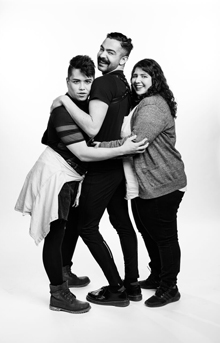The Youth/Elders Project tackles issues affecting the LGBTQIA community, on stage in Toronto
 In partnership with The 519 and the Senior Pride Network, Buddies in Bad Times has put LGBTQIA people under 25 and over 55 together in a yearlong process to create this show, The Youth/Elders Project. The results are sincere and charming, if a bit patchy.
In partnership with The 519 and the Senior Pride Network, Buddies in Bad Times has put LGBTQIA people under 25 and over 55 together in a yearlong process to create this show, The Youth/Elders Project. The results are sincere and charming, if a bit patchy.
The first half of the show is a series of short scenes, many of which involve one of the ensemble taking on the voice of another to tell a part of their story. The theatricality of this is nicely done, and it was touching to see the performers taking such care with each other’s representation.
The other scenes varied greatly. Some were hilarious, like a young woman searching for information about lesbianism on the internet and finding, instead, the ubiquitous porn. Other gems include a sing-a-long-able song about using they/them pronouns and a frenetic interpretive dance about all the letters in our community’s QUILTBAG (and some other related identities too.)
Others were darker, such as a hissing, slithering, powerful piece about anti-indigenous racism and 2 Spirit identity, and another that was wordlessly, but effectively, about HIV/AIDS.
Only one of these left me scratching my head and I still have no idea what writhing on a dinner table has to do with building structures out of empty cigarette packages, but obviously I am missing some key point of context.
My only complaint was that it didn’t really tackle any conflict between the generations. Given the premise of the show I was expecting to delve into some of the issues that exist between the young guard and the older. The Youth/Elders Project was portraying individual stories, and while we can all learn from hearing other’s personal experiences, I wanted to know how these people interacted, what they learned from each other. I wanted something with teeth, not just heart.
The second half answered that, sort of. The rest of the show is a Long Table, where the performers sit at a table, opting in and out as they wish, to answer questions. Written questions are placed in a pile in the middle of the table and someone must grab one and abruptly change the topic to that question on a lighting cue. In between, the performers can improvise from the existing conversation to ask each other about things they want to know.
This is where the show got more real and raw on opening night. After an adorable meet-cute story that was as embarrassing for the performer as it was delightful for the audience, the conversation took a turn. Tension swelled up surrounding an interaction that had happened during the development process involving the right of a person to say certain racist words. This was not even a conflict between the generations, though. While a few of the younger people made their stance on the situation clear, this was conflict that happened between older and older.
This conversation will be different every night, so I cannot say if other audiences will get to experience that uncomfortable moment. (“Uncomfortable” is not a criticism. I felt uncomfortable, and that was good. Addressing racism is not cozy, but it’s critical.) However, I imagine that The Long Table will continue to grow more and more fruitful throughout the run
Details
- The Youth/Elders Project plays at Buddies in Bad Times, 12 Alexander, until June 4, 2017
- Showtimes are Wednesday through Saturday at 8 pm with a 2:30 pm Sunday matinee
- Tickets range from $20 to $39
- Purchase tickets online or at 416.975.8555
Photo of Ty Sloane, Daniel Carter, Monica Garridoby Tanja-Tiziana
